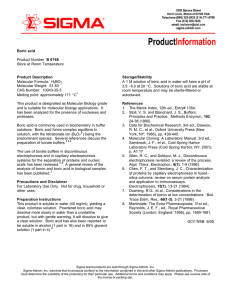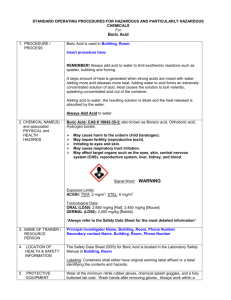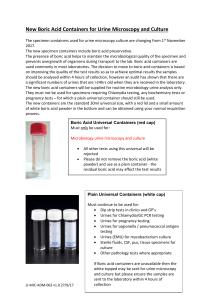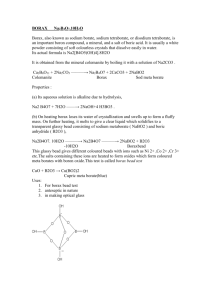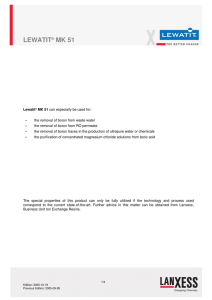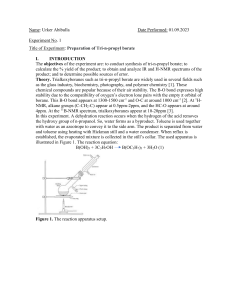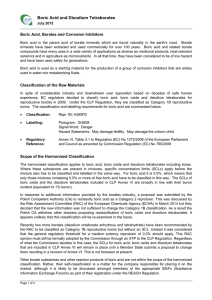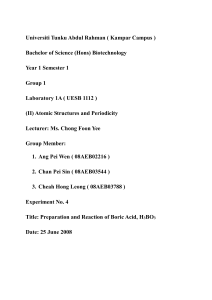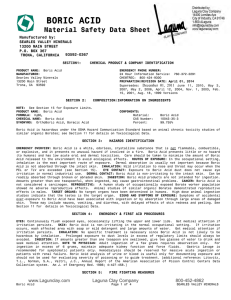BORIC ACID Sigma Prod. Nos. B0252, B7660 - Sigma
advertisement
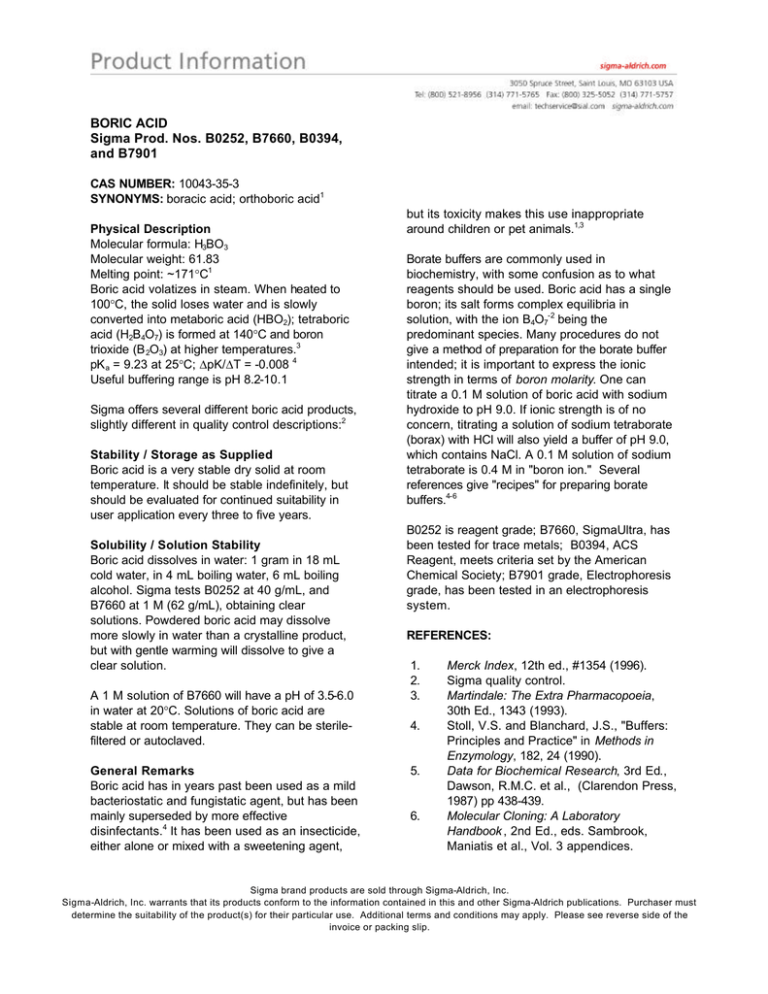
BORIC ACID Sigma Prod. Nos. B0252, B7660, B0394, and B7901 CAS NUMBER: 10043-35-3 SYNONYMS: boracic acid; orthoboric acid1 Physical Description Molecular formula: H3BO3 Molecular weight: 61.83 Melting point: ~171°C1 Boric acid volatizes in steam. When heated to 100°C, the solid loses water and is slowly converted into metaboric acid (HBO2); tetraboric acid (H2B4O7) is formed at 140°C and boron trioxide (B 2O3) at higher temperatures.3 pK a = 9.23 at 25°C; ∆pK/∆T = -0.008 4 Useful buffering range is pH 8.2-10.1 Sigma offers several different boric acid products, slightly different in quality control descriptions:2 Stability / Storage as Supplied Boric acid is a very stable dry solid at room temperature. It should be stable indefinitely, but should be evaluated for continued suitability in user application every three to five years. Solubility / Solution Stability Boric acid dissolves in water: 1 gram in 18 mL cold water, in 4 mL boiling water, 6 mL boiling alcohol. Sigma tests B0252 at 40 g/mL, and B7660 at 1 M (62 g/mL), obtaining clear solutions. Powdered boric acid may dissolve more slowly in water than a crystalline product, but with gentle warming will dissolve to give a clear solution. A 1 M solution of B7660 will have a pH of 3.5-6.0 in water at 20°C. Solutions of boric acid are stable at room temperature. They can be sterilefiltered or autoclaved. General Remarks Boric acid has in years past been used as a mild bacteriostatic and fungistatic agent, but has been mainly superseded by more effective disinfectants.4 It has been used as an insecticide, either alone or mixed with a sweetening agent, but its toxicity makes this use inappropriate around children or pet animals.1,3 Borate buffers are commonly used in biochemistry, with some confusion as to what reagents should be used. Boric acid has a single boron; its salt forms complex equilibria in solution, with the ion B4O7-2 being the predominant species. Many procedures do not give a method of preparation for the borate buffer intended; it is important to express the ionic strength in terms of boron molarity. One can titrate a 0.1 M solution of boric acid with sodium hydroxide to pH 9.0. If ionic strength is of no concern, titrating a solution of sodium tetraborate (borax) with HCl will also yield a buffer of pH 9.0, which contains NaCl. A 0.1 M solution of sodium tetraborate is 0.4 M in "boron ion." Several references give "recipes" for preparing borate buffers.4-6 B0252 is reagent grade; B7660, SigmaUltra, has been tested for trace metals; B0394, ACS Reagent, meets criteria set by the American Chemical Society; B7901 grade, Electrophoresis grade, has been tested in an electrophoresis system. REFERENCES: 1. 2. 3. 4. 5. 6. Merck Index, 12th ed., #1354 (1996). Sigma quality control. Martindale: The Extra Pharmacopoeia, 30th Ed., 1343 (1993). Stoll, V.S. and Blanchard, J.S., "Buffers: Principles and Practice" in Methods in Enzymology, 182, 24 (1990). Data for Biochemical Research, 3rd Ed., Dawson, R.M.C. et al., (Clarendon Press, 1987) pp 438-439. Molecular Cloning: A Laboratory Handbook , 2nd Ed., eds. Sambrook, Maniatis et al., Vol. 3 appendices. Sigma brand products are sold through Sigma-Aldrich, Inc. Sigma-Aldrich, Inc. warrants that its products conform to the information contained in this and other Sigma-Aldrich publications. Purchaser must determine the suitability of the product(s) for their particular use. Additional terms and conditions may apply. Please see reverse side of the invoice or packing slip.
